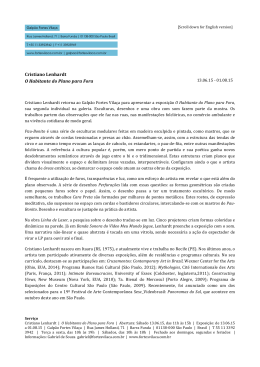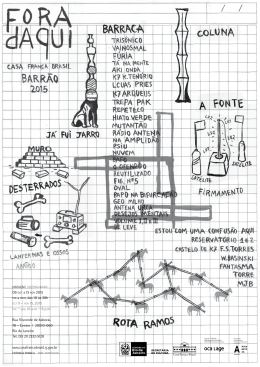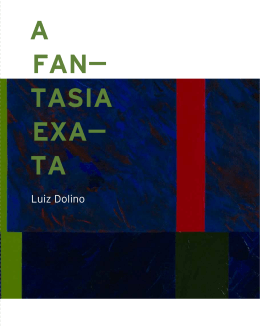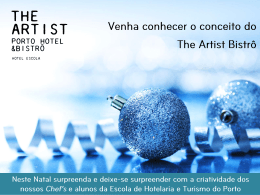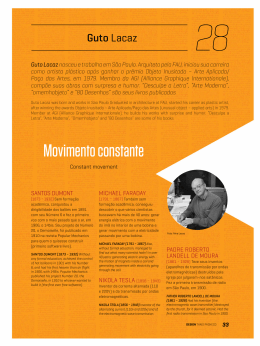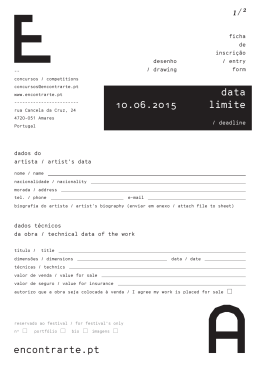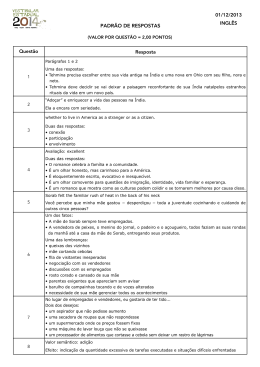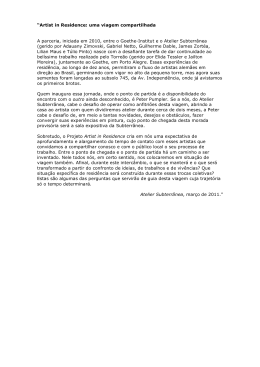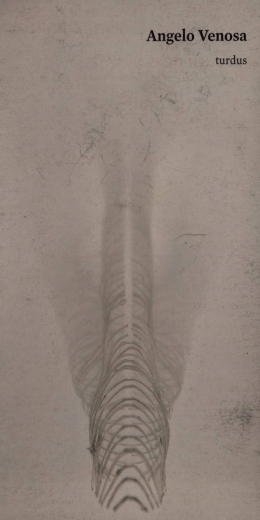JOSÉ BECHARA FENDAS 24 de novembro de 2010 a 23 de janeiro de 2011 | 4 5 Escrever este texto para o livro-catálogo da exposição de José Bechara no é um dever prazeroso. Primeiramente, pelos anos de convivência, desde nossa primeira exposição em 1992. Depois, por ser o curador do museu neste momento importante em que se realiza esta exposição antológica contemplando os vinte anos de carreira do artista. Ter ficado durante dois meses convivendo com um conjunto representativo de trabalhos do artista me fez mergulhar um pouco mais na sua obra. Ainda não deu tempo de sair completamente para fora d’água e olhar com a vista desembaçada o horizonte que se apresenta daqui para frente; mas creio que já dá para compartilhar algumas insinuações preliminares. Uma antologia de meio de carreira implica avaliação, reflexão e projeção. Reúne-se um conjunto significativo de trabalhos na tentativa de ressaltar os momentos de concentração e deslocamento da obra. Revelam-se assim os caminhos de um estilo, que nada mais é do que a busca da singularidade poética, a expressão de um princípio de individuação no interior de uma historicidade compartilhada. Se, de início, sua obra era predominantemente pictórica, com o passar dos anos, e a partir do próprio desenvolvimento de sua poética, ela foi incorporando elementos escultóricos e começou a dialogar mais diretamente com 7 a arquitetura. A saturação das oxidações foi se acumulando, por pressão da própria maturação do seu processo, na superfície das lonas e se projetando no espaço. Este jogo entre saturação e estruturação acompanha o desenrolar do trabalho. Ora predomina a densidade matérica, o acúmulo de elementos que se concentram e se expelem, ora sobressai o esforço estruturante, a grade geométrica e o desenho linear. Creio que os primeiros dez anos de sua trajetória foram de enfrentamento direto da pintura e sua crise. No seu caso, somou-se à dimensão histórica da crise – que tocava a todos os jovens artistas que se formavam ainda no refluxo da década de 1980 e do seu “retorno” ao mesmo tempo festivo e nostálgico à pintura – um elemento pessoal causado pela proibição médica de contato com tintas e solventes. A solução foram lonas de caminhão usadas e marcadas pelo tempo e a oxidação feita com chumaços de bombril. A primeira etapa do processo vinha da escolha e recorte de pedaços 9 de lona já interessantes plasticamente: com manchas, rasgos, resíduos gráficos, acúmulos de uma memória visual do tempo de uso e desgaste constante. Esta seleção já implicava um fazer pictórico, constituído pelo olhar do pintor e sua intuição sobre o que poderia se desdobrar a partir dali. Nas pinturas até meados dos anos 1990, a tensão acontecia no embate entre a pulsação temporal da ferrugem, a memória visual acumulada e a organização geométrica da forma na superfície da tela. Cada vez mais, com o maior controle sobre o processo de oxidação, conquistado empiricamente na lida diária do ateliê, com seus acertos e recuos, a pulsação passou a acontecer pela densidade matérica atuando e se expandindo no interior da grade geométrica. O movimento para fora, o salto além do plano, estava dado. Neste ponto, no começo da década passada, há uma inflexão poética em sua trajetória. A concentração obsessiva, com um material e um processo restrito e repetido à exaustão, desloca-se para o embate mais dispersivo com o espaço exterior, obrigando-o a multiplicar os materiais e as estratégias poéticas. 11 A partir daí, ao sair do plano, o embate passa a se dar no atrito com a própria arquitetura, pela desestabilização da sua geometria ordenadora. Há um jogo intenso entre serialidade e singularidade, entre o dentro e o fora, entre a escala (monumental) e o afeto (íntimo). Se, nas lonas enferrujadas, era uma “coisa” do mundo, a lona usada, que se transformava pela intervenção plástica do artista, virtualizando-se no plano, agora, nesta produção polifônica mais recente, pelo deslocamento das tensões entre a geometria e a pulsação matérica, nascidas no interior do seu vocabulário pictórico, é o próprio espaço do mundo que se desestabiliza. O jogo com as escalas, a multiplicação de suportes, as passagens (ou fendas, como prefere o artista) entre o dentro e o fora, o virtual e o atual, vão constituindo campos de imantação poética no limite do simbólico, no ponto em que a metáfora e a coisa, a poesia e a literalidade, negociam suas intensidades. Nos trabalhos mais recentes, um deles feito durante a montagem da exposição, usando vidro, oxidação, papel, fórmica, e mais a parede, os cantos da sala e os reflexos de luz, Bechara parece 13 desviar seu foco poético para um jogo mais virtual entre o corpo, o espaço e a arquitetura. Misturando a fragilidade dos materiais, a precisão das incisões geométricas e a instabilidade compositiva, estas peças nos repõem, à sua maneira, na tensão já assinalada do íntimo e do impessoal. Tudo está no limite da dissolução, da quebra, da decomposição. As cores, que também começam a aparecer mais nitidamente na produção atual, são uma novidade curiosa. Nessas peças de vidro, apesar das tonalidades frias, um rosa e um verde esmaecidos, a cor na sua opacidade vazia, quase kitsch, entra para desestabilizar a geometria. Nos desenhos em que sobressai uma gestualidade destemida, a cor apesar de vibrante é o elemento que segura a forma; ao contrário das oxidações em cobre, cujo tom esverdeado dilui a grade estrutural. Um pouco de nossos desafios contemporâneos se encontra nesta tensão, um tanto angustiada, mas sempre renovada, entre uma estruturação formal e uma individuação poética. Vários momentos da obra de Bechara cabem aí dentro e seus desdobramentos recentes parecem atualizá-la e intensificá-la. Luiz Camillo Osorio, 2011 15 english version It has been a great pleasure to write this text for the catalogue accompanying the José Bechara exhibition at . First, because of our history of collaboration that goesback to our first exhibition in 1992, but also because I am the museum curator during this exhibition of the past twenty years of the artist’s work. Spending two months with a representative sample of the Bechara’s work has made me delve a little deeper into this career. I have still not had time to come completely out of the water and get a clear view of the horizon that stretches out ahead; but I believe I can share a few preliminary observations. A mid-career retrospective involves re-appraisal, reflection, and projection. It brings together a significant body of the artist’s work in an effort to bring to light the shifting focuses of his work. You can see how his style has developed, which is nothing more than a search for something that is artistically unique, the expression of a principal of individuality within a shared historical context. If, from the outset, his work was predominantly pictorial, as the years passed and as he developed his own style, it came increasingly to incorporate sculptural elements and to enter into a more direct dialogue with architecture. The canvases come to be more saturated with oxidized elements as the artist’s creative process 17 matures and to project out more into space. This play of saturation and structure runs through the whole oeuvre. At times it is the density of the material that predominates, at time the accumulation of elements that are concentrated and thrown out; at others, it is the effort to create structure, the geometrical grid and the line drawing. I think that in the first ten years of his career Bechara directly confronted the issue of painting and the crisis it was going through. In his case the historical dimension of this crisis – which affected all the young artists who emerged in the 1980s and the at once festive and nostalgic “return” to painting – was allied to personal limitation caused by a medical condition that did not allow him to come into contact with paints and solvents. His solution was to use truck canvases marked by time and rust made with steel wool. The first stage in the process is the selection and cutting up of the already visually interesting pieces of canvas: torn and stained, with a visual memory built up over time by constant wear and tear. This selection process was already a form of painting based on the artist’s eye and sense for what the canvas might become. In the paintings produced before the mid-1990s, the tension came from the clash between the temporal pulse of the rusting, the accumulated visual memory, and the geometrical organization of shapes on the canvas surface. As, through daily empirical struggles in his studio, he wrestled to gained control of the oxidation process, the pulse increasingly began to derive from 19 the density of the material expanding within the geometrical grid. The outward movement, the leap beyond the flat surface, began. At this point, at the beginning of the last decade, there was a poetic shift in his work. The obsessive concentration on the use of a single material and a restricted process repeated to the point of exhaustion gave way to a more disparate engagement with the outside world, obliging the artist to diversify both the materials and his artistic strategies. From this point on, with this move away from the flat surface, the clash comes to derive from the friction between the work and the surrounding architecture, from the destabilizing effect it has on its own geometrical order. There is an intense play between serialism and singularity, between inside and outside, between (monumental) scale and (intimate) affect. Whereas, in the rusted canvases, the used canvas was a “thing” found in the world that was transformed by the artist’s intervention, becoming virtual on the flat surface, now, in the more recent polyphonic work, it is the very space of the world that is destabilized by the shifting tension between geometry and the pulse of the matter, arising from the heart of his pictorial vocabulary. The play of scales, the diversity of supports, the movement (or rifts, as the artist would have it) between inside and outside, virtual and actual, build up magnetic poetic 21 fields on the edge of the symbolic, at a point where metaphor and thing, the literal and the poetic compete for attention. In the more recent works, one of them put together as the exhibition was assembled, using glass, rust, paper, formica and the museum wall itself, the corners of the room and the reflections of the light, Bechara seems to be shifting his poetic focus towards a more virtual play of body, space and architecture. With their mixture of fragile materials, precise geometrical incisions and compositional instability, these pieces bring us back, in their own way, to the tension between the intimate and the impersonal referred to above. Everything is on the brink of melting away, breaking down, being decomposed. The colors, which also begin to appear more clearly in the artist’s recent work, are a curious novelty. In these glass pieces, despite the cold tones, a faded pink and green, color in its empty opaqueness, almost kitsch, comes in to destabilize the geometry. In the drawings in which the artist’s bold use of strokes is the most striking feature, the color, though vibrant, is the element that holds the form; different from the oxidizing copper, whose greenish tone waters down the structure of the grid. There is something of the challenges of the contemporary world in this tension, somewhat anguished, but always renewed, between formal structure and individual creativity. Various stages in Bechara’s career could be described like this and his most recent work seems to update and intensify this relationship. Luiz Camillo Osorio, 2011 23 27 29 30 32 35 36 39 40 43 44 46 47 48 50 52 54 56 59 60 62 63 64 65 66 67 68 69 OBRAS | WORKS p. 4 RUN # 1, 2004 p. 41 DUAS COMIGO p. 64 SéRIE DE PEQUENOS DíPTICOS Título original e provisório para o trabalho Ok ok let’s talk [da série Anotações para execução da peça Ok ok let’s talk] Original, provisional title for Ok ok let’s talk [from the series Notes and studies on Ok ok let’s talk] Impressão de jato de tinta sobre papel Ink jet print on paper 21,5 x 27,9 cm [DA SéRIE AR | FrOM THe Ar SerIeS], 2009 SerIeS OF SMAll dIPTyCHS, 2009/2010 Emulsão vinílica sobre papel Debret 200g Vinyl emulsion on 200g debret paper Pinturas em oxidação de aço, emulsão cúprica e óleo sobre tela e lona usada de caminhão | Paintings in rusted steel, copper emulsion and oil on canvas and tarpaulin from used truck 70 x 60 cm cada | each Coleção do artista | Artist’s collection 151 x 191,5 cm p. 44 SEM TíTULO | UNTITled, 2010 Oxidação de aço e emulsão cúprica sobre lona | rusted steel and copper emulsion on tarpaulin p. 25, 26, 28, 32, 50, 58, 60, 65 280 x 280 cm Vista parcial da exposição no Salão Monumental | Partial view of the exhibition at the Monumental Hall, MAM, Rio de Janeiro, 2010 Foto| Photo Julio Callado Coleção do artista | Artist’s collection Foto| Photo Julio Callado p. 30, 36, 38, 42, 46, 48, 53, 54, 56, 63 Vista parcial da exposição no Salão Monumental | Partial view of the exhibition at the Monumental Hall, MAM, Rio de Janeiro, 2010 Foto| Photo Vicente de Mello p. 45 SEM TíTULO | UNTITled, 2010 Oxidação de aço e emulsão cúprica sobre lona | rusted steel and copper emulsion on tarpaulin 240 x 160 cm Coleção do artista | Artist’s collection Foto| Photo Julio Callado p. 47 SEM TíTULO [DA SéRIE GRADES] p. 34 MARGARIDA STRIPE | STrIPed dAISy, 2008 UNTITled [FrOM THe rAIlINGS SerIeS], 1995 Oxidação de aço sobre lona usada de caminhão | rusted carbon steel on tarpaulin from used truck Oxidação de aço carbono sobre lona de caminhão usada | rusted carbon steel on tarpaulin from used truck 130 x 640 cm 200 x 150 cm Coleção do artista | Artist’s collection Foto| Photo Vicente de Mello Coleção| Collection Gilberto Chateaubriand p. 62 FANTáSTICA [DA SéRIE OPEN HOUSE] p. 40 DUAS CONTIGO FANTASTIC [FrOM THe OPeN HOUSe SerIeS], 2006 [DA SéRIE AR | FrOM THe Ar SerIeS], 2009 2/2 Emulsão vinílica sobre papel Debret 200g Vinyl emulsion on 200g debret paper Fórmica e MDF | Formica and MdF Dimensões variáveis | Variable dimensions Coleção| Collection of Ricardo Rego 151 x 191,5 cm p. 66 SEM TíTULO [DA SéRIE GELOSIA] UNTITled [FrOM THe GelOSIA SerIeS], 2010 Oxidação de emulsão ferrosa sobre vidros e tinta acrílica | rusted iron emulsion on glass and acrylic paint Dimensões variáveis | Variable dimensions Coleção do artista | Artist’s collection Foto| Photo Julio Callado p. 68, 69 PINK GELOSIA [DA SéRIE GELOSIA | FrOM THe GelOSIA SerIeS], 2010 Oxidação de emulsão ferrosa sobre vidros e tinta acrílica | rusted iron emulsion on glass and acrylic paint Dimensões variáveis | Variable dimensions Coleção do artista | Artist’s collection Foto| Photo Julio Callado MUSEU DE ARTE MODERNA PRESIDENTE | PRESIDENT SÓCIOS E PARCEIROS | ASSOCIATES AND PARTNERS RECEPÇÃO | RECEPTION Rio de Janeiro Carlos Alberto Gouvêa Chateaubriand Alessandro Hage Av. Infante Dom Henrique, 85 Parque do Flamengo 20021-140 – Rio de Janeiro/RJ Brasil www.mamrio.org.br VICE-PRESIDENTE | VICE PRESIDENT DESIGN Tânia Nascimento, Fabiana Lima, Janaina Amorim dos Santos João Maurício de Araujo Pinho Filho Carla Marins [Coordenadora Coordinator] Rafael Rodrigues Mariana Boghossian [Estagiários Trainee] DIRETOR | DIRECTOR Luiz Schymura CONSELHO DELIBERATIVO | DELIBERATIVE COUNCIL MANTENEDORES | SPONSORS Petrobras Light PARCEIROS | PARTNERS Bolsa de Arte do Rio de Janeiro Credit Suisse Hedging-Griffo Investidor Profissional Mica Mídia Cards Outback Steakhouse Revista Piauí Salta Elevadores Lei de Incentivo à Cultura | Ministério da Cultura PROJETOS ESPECIAIS | SPECIAL PROJECTS Biblioteca Aquisição de Mobiliário e Equipamentos – Secretaria de Estado de Cultura Cinemateca Aquisição de Acervo e Digitalização de Acervo Documental – ONS Operador Nacional do Sistema Elétrico Núcleo Experimental de Educação e Arte – Unimed, Petrobras TAM – transportadora oficial do Armando Strozenberg Carlos Alberto Gouvêa Chateaubriand Demósthenes M. de Pinho Filho Elisabete Carneiro Floris Gilberto Chateaubriand [Presidente President] Gustavo Martins de Almeida Heitor Reis Helio Portocarrero Henrique Luz Irapoan Cavalcanti de Lyra João Maurício de Araujo Pinho [Vice Presidente Vice President] João Maurício de Araujo Pinho Filho Joaquim Paiva José Luiz Alquéres Kátia Mindlin Leite Barbosa Luis Antonio de Almeida Braga Luiz Carlos Barreto Luiz Schymura Nelson Eizirik Paulo Albert Weyland Vieira ARTES PLÁSTICAS | VISUAL ARTS Luiz Camillo Osorio [Curador Curator] Frederico Coelho [Assistente Assistant] MUSEOLOGIA | MUSEOLOGY Claudia Calaça [Coordenadora Coordinator] Veronica Cavalcante Cátia Louredo Fátima Noronha Camila Silveira de Pinho [Estagiária Trainee] PRODUÇÃO | PRODUCTION Hugo Bianco [Coordenador Coordinator] Tânia Pinta ASSESSORIA DE IMPRENSA | PRESS CW&A Comunicação MONTAGEM | SETTING UP Cosme de Souza José Marcelo Peçanha Rafael Campos SALÃO DE EXPOSIÇÕES | EXHIBITION HALL Marcio Andre Oliveira Evelin Cristina Damascena Lima Rodrigo de Lima Rosa Terezinha Silva de Oliveira José Luiz Nery Filho PESQUISA E DOCUMENTAÇÃO | DOCUMENTATION AND RESEARCH Rosana de Freitas [Curadora Curator] Adriano Braz Claudio Barbosa Mauricio Sales de Brito Elizabeth Varela Verônica Sá Ferreira CINEMATECA | FILM ARCHIVE Gilberto Santeiro [Curador Curator] Hernani Heffner [Assistente Assistant] Carlos Eduardo Pereira João Roberto Costa José Quental Sidney de Mattos OPERAÇÕES E EVENTOS | OPERATIONS AND EVENTS Cláudio Roberto ADMINISTRAÇÃO E FINANÇAS | MANAGEMENT AND FINANCES Henrique Andrade Oliveira [Coordenador Coordinator] Cláudio Pereira Eduardo Gomes Chaves Sandra Borges dos Santos Leandro Oliveira de Souza Edson Gomes dos Santos Jr. LIMPEZA | CLEANING Adriana da Silva Pereira, José Geraldo Avelino, Juarez Lacerda Leal, Luiz Carlos dos Santos, Neuza Costa Pinheiro, Tereza Cristina Vasconcelos, Glayton Amaral Lisboa, Carlos Magno Silva Leocádio NÚCLEO EXPERIMENTAL DE EDUCAÇÃO E ARTE EXPERIMENTAL NUCLEUS OF EDUCATION AND ART Instituto Mesa [Coordenação Geral General Coordination] Jessica Gogan Luiz Guilherme Vergara Renata Montechiare Sabrina Curi COORDENADORA DE AÇÕES E CONTEÚDO | CONTENT AND ACTION COORDINATOR Mara Pereira PRODUÇÃO EXECUTIVA | EXECUTIVE PRODUCTION Bebel Kastrup ASSISTENTE DE PRODUÇÃO | PRODUCTION ASSISTANT Taisa Moreno ARTISTAS/EDUCADORES | ARTISTS/EDUCATORS Anita Sobar, Bianca Bernardo, Virgínia Mota, Leonardo Campos PESQUISADORAS/EDUCADORAS | RESEARCHERS / EDUCATORS Ana Paula Chaves, Maíra Dias MEDIADORES | MEDIATORS Anderson Araújo, Elielton Rocha COORDENAÇÃO DO PROGRAMA PARA FAMÍLIAS | FAMILY PROGRAMS COORDINATOR Ignês Albuquerque MANUTENÇÃO | MAINTENANCE Behar Engenharia SEGURANÇA | SECURITY Transegur Vigilância e Segurança PRODUÇÃO | PRODUCTION AUXILIAR ADMINISTRATIVO AGRADECIMENTOS | ACKNOWLEDGMENTS Automatica ADMINISTRATIVE ASSISTANT Dedina Bernardelli Carolina Lima Adolfo Montejo Navas Ana Luiza e Mariano Marcondes Ferraz Carlos Alberto Gouvêa Chateaubriand Genny e Selmo Nissenbaum Gilberto Chateaubriand Maneco Müller Plínio Quintão Fróes e equipe Rio Scenariun Reynaldo Roels (in memoriam) Ricardo Rego Silvio Pozzato Wilson Coutinho (in memoriam) COORDENAÇÃO GERAL GENERAL COORDINATOR ILUMINAÇÃO | LIGHTING Luiza Mello Traquitana PROJETO | LIGHTING DESIGN CURADORIA | CURATOR Tomás Ribas Luiz Camillo Osorio ASSISTENTE | ASSISTANT Leopoldo Victor PRODUÇÃO | PRODUCTION EQUIPE DE MONTAGEM | EXHIBITION Camila Goulart CONSTRUCTION TEAM Sandro de Lima Leite e Boy Jorge COORDENAÇÃO ATELIER STUDIO COORDINATOR MAQUETE | MODEL Natasha Ribeiro Bergottini Robério Catelani ARQUITETURA | ARCHITECTURE FOTOGRAFIA | PHOTOGRAPHY Pedro évora e Pedro Rivera | RUA arquitetos Julio Callado Vicente de Mello EQUIPE ATELIER | STUDIO TEAM ESTAGIÁRIA DE PRODUÇÃO | INTERN Aline Araujo Assumpção Enna Beatriz Antonia de Alcântara Felipe de Queiroz Coutinho Pedro Henrique Feitosa da Silva Esther Martins DESIGN GRÁFICO | GRAPHIC DESIGN VERSÃO PORTUGUÊS - INGLÊS Rara Dias | Zot Design Paula Delecave PORTUGUESE - ENGLISH TRANSLATION ASSESSORIA DE IMPRENSA | PRESS RELATIONS SEGURO | INSURANCE CW&A Comunicação Foco Art Group 11-2361. GESTÃO DO PROJETO | PROJECT MANAGER TRANSPORTE DAS OBRAS | TRANSPORTATION Marisa Mello Millenium Transportes e Logística 29.04.11 02.05.11 CIP-BRASIL. CATALOGAÇÃO-NA-FONTE SINDICATO NACIONAL DOS EDITORES DE LIVROS, RJ B354f patrocínio Bechara, José, 1957Fendas : José Bechara / [curadoria da exposição e texto do catálogo Luiz Camillo Osorio ; coordenação geral Luiza Mello ; versão para o inglês Paul Webb]. - Rio de Janeiro : Automatica, 2010. 64p. : il. color. REVISÃO DE TEXTO | PROOFREADING Duda Costa Texto em português e inglês Catálogo da exposição realizada no Museu de Arte Moderna do Rio de Janeiro de 24 de novembro de 2010 a 23 de janeiro de 2011 ISBN 978-85-64068-05-6 Paul Webb produção 1. Bechara, José, 1957- - Exposições - Catálogos. 2. Arte brasileira Séc. XXI - Brasil - Exposições - Catálogos. I. Osorio, Luiz Camillo, 1963-. II. Museu de Arte Moderna do Rio de Janeiro. III. Título. apoio realização CDD: 709.81 CDU: 7.036(81) 026041
Download
